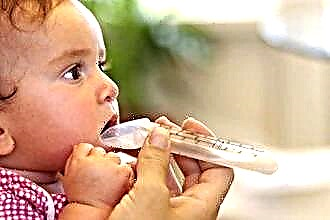Newborns and infants are not able to inform their parents about the presence of discomfort in the oropharynx when swallowing. How to understand that a baby has a sore throat? It is possible to determine the presence of inflammatory processes in the airways by changes in the child's behavior.
 Hyperemia of the mucous membranes is one of the key symptoms indicating the development of infectious processes in the ENT organs.
Hyperemia of the mucous membranes is one of the key symptoms indicating the development of infectious processes in the ENT organs.
Pain and discomfort when swallowing affect the newborn's well-being and behavior. Hypersalivation (salivation) and refusal to eat are the main signs of the development of catarrhal processes in the respiratory organs.
Only a pediatrician can accurately determine the type of pathology and the optimal course of treatment after a visual examination of the patient and identification of characteristic local manifestations of inflammation.
How to recognize a malaise?
Sore throat occurs due to tissue inflammation and subsequent irritation of the nociceptors. Septic inflammation occurs as a result of damage to the mucous membranes of the respiratory system by pathogenic bacteria or viruses. The newborn cannot directly inform the parents about the presence of discomfort, which in most cases prevents the timely passage of therapy.
How to understand that a child is ill and has a sore throat? It is possible to determine the presence of pathological changes in the throat by indirect manifestations, which include:
- hypersalivation - increased salivation occurs as a result of dysfunction of the ciliated epithelium. Inflammation of the tissues stimulates the hypersecretion of mucus, which the child cannot swallow due to the pain that occurs during swallowing;
- tearfulness - perspiration, dryness and pain in the throat make the child react to discomfort by crying, which is aggravated by swallowing saliva;
- refusal to eat - when feeding, the milk mixture additionally irritates the hyperemic mucous membrane of the throat, as a result of which the child refuses to eat;
- poor sleep - severe pain and a lump in the throat syndrome stimulate the nervous system, as a result of which the newborn cannot fall asleep or sleeps for only 20-30 minutes.
In the event of the above symptoms, it is advisable to examine the patient's throat using an examination stick or a teaspoon with a flat handle. If inflammatory processes are detected, it is necessary to seek the help of a specialist.
Local manifestations
It should be understood that late diagnosis of ENT diseases can lead to disastrous consequences. Due to the anatomical features of the structure of the nasopharynx and the looseness of the mucous membranes, the infection progresses rapidly. This can lead to the development of local and systemic complications, which include sinusitis, otitis media, pharyngitis, tracheitis, etc.
If changes in the behavior of the newborn are detected, it is necessary to conduct an independent examination of the mucous membrane of the oropharynx. The following local manifestations will indicate the presence of pathological changes in tissues:
- swelling - inflammatory processes in the ciliated epithelium lead to thinning of the walls of blood and lymphatic vessels, as a result of which severe edema occurs near the foci of inflammation;
- hyperemia - with an infectious lesion of the mucous membrane, the regional blood supply increases, which leads to reddening of the glands and lymphoid tissues;
- white bloom on the walls of the throat - the formation of white
 plaque on the walls of the throat, palatine arches and tonsils indicates the development of bacterial inflammation;
plaque on the walls of the throat, palatine arches and tonsils indicates the development of bacterial inflammation; - enlargement of lymph nodes - infectious processes in the throat and airways stimulate immune activity, which inevitably leads to an increase in regional lymph nodes - submandibular, cervical, occipital;
- hypertrophy of the palatine tonsils - pathogens localized in lymphadenoid clusters provoke allergic reactions and inflammation, as a result of which an increase in the glands is observed.
Local manifestations of infectious diseases are nonspecific, therefore, it is almost impossible to visually distinguish angina from influenza in a newborn, especially in the case of an atypical course of the pathology. For this reason, a sick child should be taken to a pediatrician, who, after a visual examination, will take a biomaterial (swab) from the throat for microbiological analysis. Based on the results of bacterial seeding, the specialist will be able to determine the causative agent of the infection, the type of ENT disease and, accordingly, the optimal course of treatment.
Concomitant symptoms
The presence of infectious inflammation in the respiratory organs can be judged by the concomitant manifestations. Pathogens localized in the mucous membranes of the oropharynx poison the body with the products of their vital activity, resulting in general symptoms of intoxication. The characteristic manifestations of respiratory diseases in newborns include:
- fever;
- hyperthermia;
- cough;
- labored breathing;
- wheezing in the lungs;
 runny nose.
runny nose.
It should be understood that a baby is not able to complain about specific manifestations of the disease, such as headaches, dry throat, lethargy, etc.
All of the above signs can signal the development of more than 10 different pathologies, the treatment of which has fundamental differences.
That is why a newborn must undergo differential diagnosis from a pediatrician, who will be able to determine the type of ENT disease for sure.
Possible diseases
What diseases in infants can have a sore throat? Inflammatory processes in the respiratory tract indicate the development of fungal, viral or bacterial flora. Flushing and sore throat are typical manifestations of the following types of ENT diseases:
- pharyngitis;
- flu;
- tracheitis;
- tonsillitis;
- pharyngomycosis;
- laryngitis.
Bacterial infections pose a particular threat to the life of newborn babies.
Pathogenic microbes, especially streptococci, lead to severe intoxication of the body. Due to sensitization, young children are more prone to allergic reactions than adults. Therefore, in the case of the development of bacterial inflammation (tonsillitis, pharyngitis), local complications often occur in the form of false croup and paratonsillar abscess.
When to see a pediatrician?
 Late treatment of septic inflammation of the ENT organs often leads to the chronicization of pathological processes. Swelling of the tissues can cause hypoxia (lack of oxygen), which inhibits the normal physical and mental development of the child. To prevent complications, you need to seek medical help if you find the following signs:
Late treatment of septic inflammation of the ENT organs often leads to the chronicization of pathological processes. Swelling of the tissues can cause hypoxia (lack of oxygen), which inhibits the normal physical and mental development of the child. To prevent complications, you need to seek medical help if you find the following signs:
- labored breathing;
- suffocating cough;
- wheezing in the lungs;
- lack of voice;
- febrile fever;
- an increase in the palatine tonsils.
Prolonged hyperthermia can cause febrile seizures in a newborn.
Timely provision of medical care prevents the spread of inflammatory processes and the development of post-infectious complications. Competent treatment accelerates the regression of pathological processes, tissue regeneration and, accordingly, the relief of pain in the throat.
Features of therapy
Drug therapy for ENT diseases in children under six months is very limited, since many medications cause allergic reactions, which aggravates the patient's condition.The use of mouthwashes and throat sprays can result in drug aspiration, which can lead to bronchial obstruction.
What medications and treatments can be used in pediatric therapy?
- lubrication of the mucous membrane of the oropharynx with "Iodinol" and "Lugol's solution";
- instillation of Aqua Marisa and saline into the nose;
- processing of a pacifier with "Chlorophyllipt" and "Miramistin";
 inhalation with a nebulizer using "Dioxidine" and "Ceftriacone".
inhalation with a nebulizer using "Dioxidine" and "Ceftriacone".
In the case of using symptomatic agents, it is better to give preference to drugs in the form of suspensions, syrups and rectal suppositories.
The treatment regimen for ENT disease should be determined only by the attending physician.
In the absence of positive dynamics, the specialist can change the direction of therapy or replace ineffective medications with stronger ones.

 plaque on the walls of the throat, palatine arches and tonsils indicates the development of bacterial inflammation;
plaque on the walls of the throat, palatine arches and tonsils indicates the development of bacterial inflammation; runny nose.
runny nose. inhalation with a nebulizer using "Dioxidine" and "Ceftriacone".
inhalation with a nebulizer using "Dioxidine" and "Ceftriacone".

